GitHub Staff
GitHub is the world's best developer experience and the only AI-powered platform with security incorporated into every step, so you can innovate with confidence.
In this year’s Octoverse, we uncover how AI, agents, and typed languages are driving the biggest shifts in software development in more than a decade.
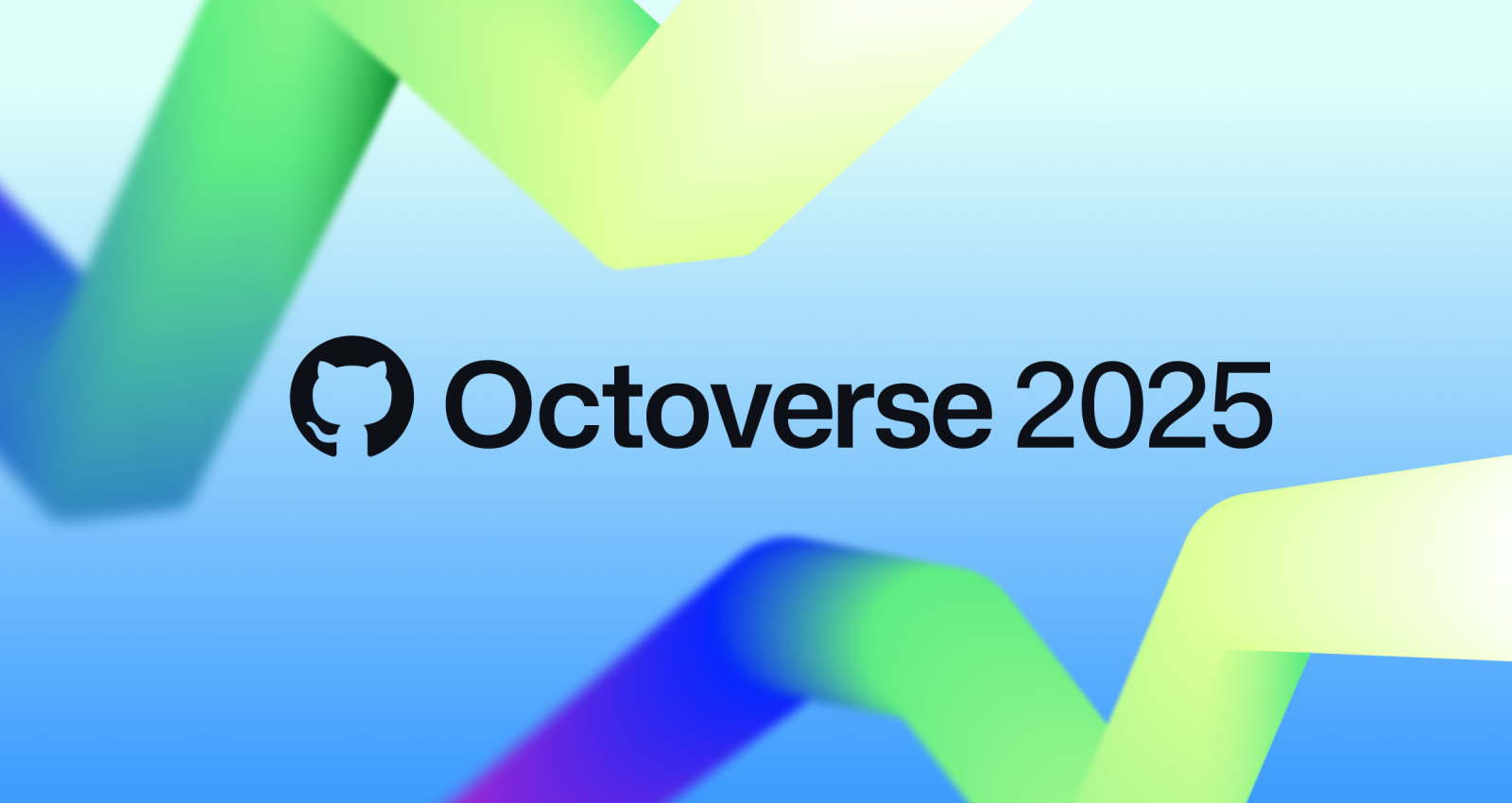
If 2025 had a theme, it would be growth. Every second, more than one new developer on average joined GitHub—over 36 million in the past year. It’s our fastest absolute growth rate yet and 180 million-plus developers now work and build on GitHub.
The release of GitHub Copilot Free in late 2024 coincided with a step-change in developer sign-ups, exceeding prior projections. Beyond bringing millions of new developers into the ecosystem, we saw record-level activity across repositories, pull requests, and code pushes. Developers created more than 230 new repositories every minute, merged 43.2 million pull requests on average each month (+23% YoY), and pushed nearly 1 billion commits in 2025 (+25.1% YoY)—including a record of nearly 100 million in August alone.
This surge in activity coincides with a structural milestone: for the first time, TypeScript overtook both Python and JavaScript in August 2025 to become the most used language on GitHub, reflecting how developers are reshaping their toolkits. This marks the most significant language shift in more than a decade.
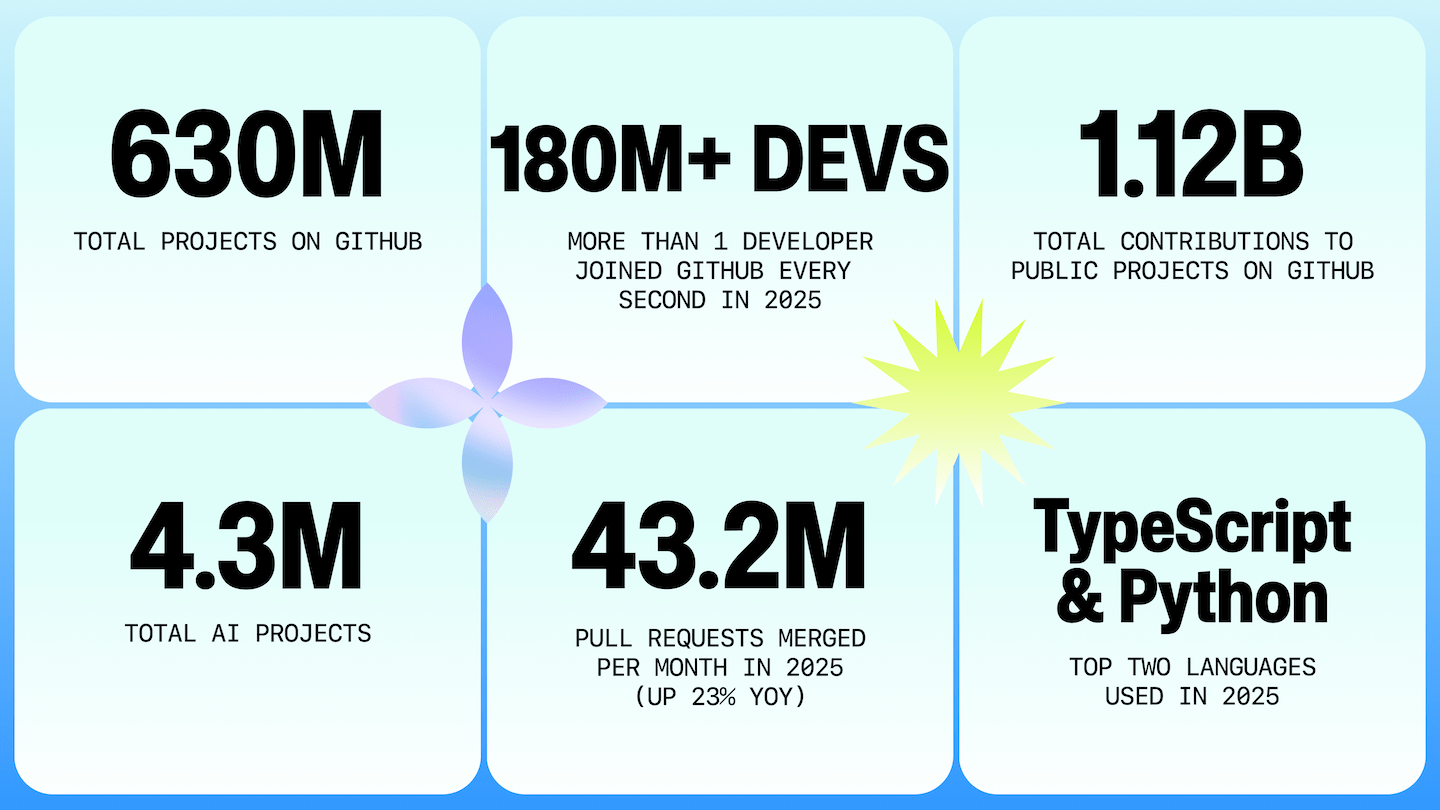
And the growth we see is global: India alone added more than 5 million developers this year (over 14% of all new accounts) and is on track to account for one in every three new developers on GitHub by 2030.
This year’s data highlights three key shifts:
And one of the biggest things in 2025? Agents are here. Early signals in our data are starting to show their impact, but ultimately point to one key thing: we’re just getting started and we expect far greater activity in the months and years ahead.
Let’s jump in.
💡 Oh, and if you’re a visual learner, we have you covered.👇

In 2023, GitHub crossed 100 million developers after nearly three years of growth from 50 million to 100 million. But the past year alone has rewritten that curve with our fastest absolute growth yet. Today, more than 180 million developers build on GitHub.
So, what does “more than one new developer joining GitHub every second on average” actually mean?
Historically, developer sign ups and repository creation followed predictable year-over-year patterns. The launch of Copilot Free in December 2024 accelerated those curves globally, giving millions access to AI-powered workflows for the first time. The end result? Our typical models for growth overturned dramatically.
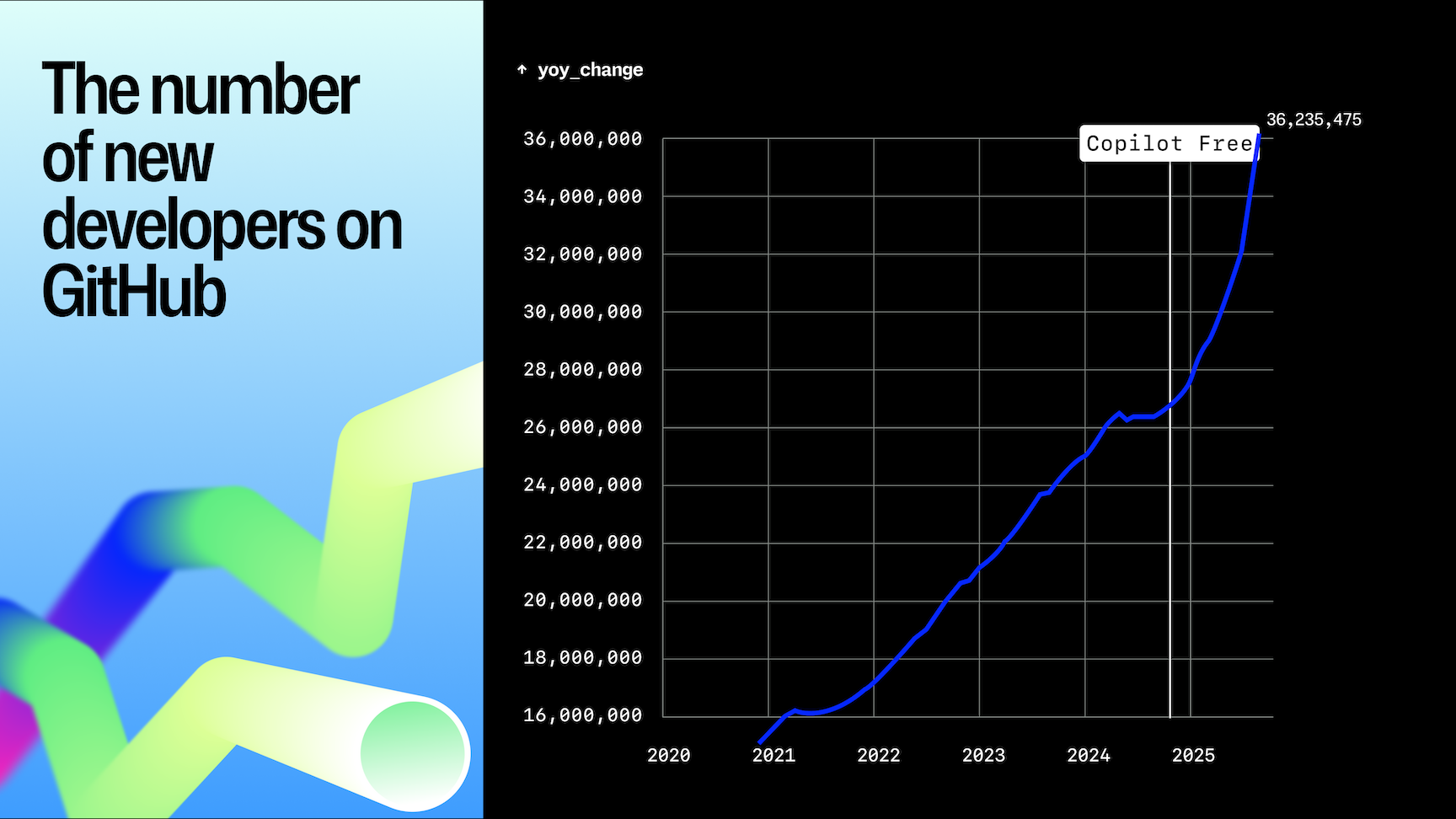
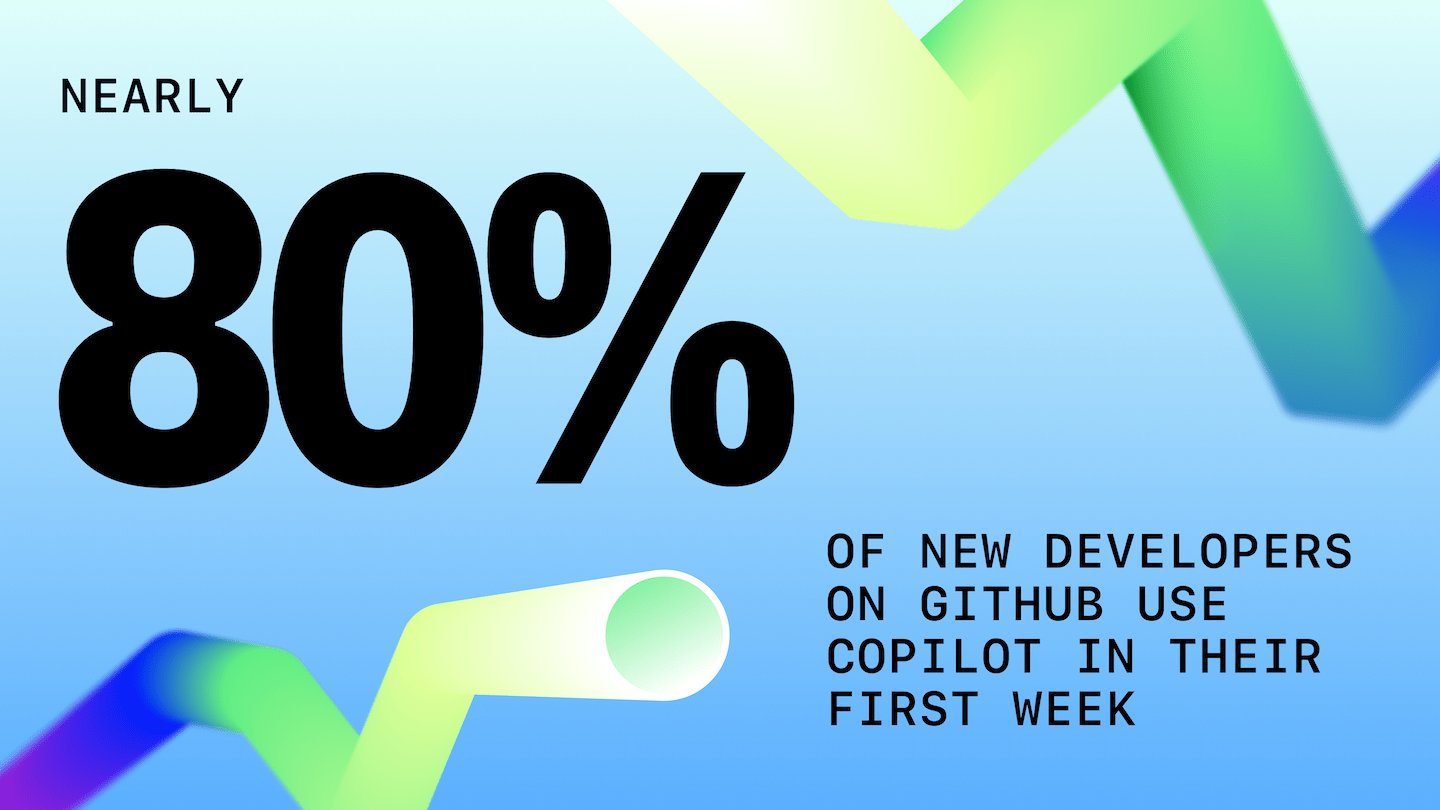
In 2025, 81.5% of contributions happened in private repositories, while 63% of all repositories were public. The split highlights GitHub’s dual role: most day-to-day work takes place in private projects, but depends on libraries, models, and frameworks in public open source.
Private repositories also grew faster (+33% YoY) than public repositories (+19% YoY), reflecting the growth in organizational development happening on GitHub. We also sometimes see open source software (OSS) work start in private projects.
| 2025‑YTD lens | Contributions | Share of total | What it signals |
|---|---|---|---|
| Private repositories | 4.97B | ≈ 81.5% | Enterprise and team‑level collaboration is happening on GitHub. |
| Public repositories | 1.12B | ≈ 18.5% | The volume of work is smaller, yet these projects supply the libraries, models, and workflows that power the broader ecosystem. |

2025 marked the most active 12-month period in GitHub history with more than 1.12B contributions to public and open source projects. Following the SPACE framework (a model that looks at developer Satisfaction, Performance, Activity, Communication, and Efficiency), this increase reflects record levels of developer activity. As developers are increasingly working with LLMs and agents, there are some new, notable correlations in this year’s data.
Across every productivity signal on GitHub, developers set new records in 2025.
| Activity | 2024 monthly average | 2025 monthly average |
|---|---|---|
| Issues closed | ≈ 3.4M | 4.25M |
| Pull requests merged | 35M | 43.2M |
| Code pushes | 65M | 82.19M |
Momentum accelerated in early 2025 and coincided with the preview of Copilot coding agent in March and the introduction of Copilot code review in April. In March, developers closed 1.4 million more issues than the prior month, then continued breaking records, culminating in 5.5 million issues closed in July.
Code pushes are driving the surge with more than 986M commits in 2025 (+25% YoY) and monthly pushes topping 90M by May. Other activity followed:
These are observational signals rather than causal claims and more work is needed to understand the full impact AI is having in software development.
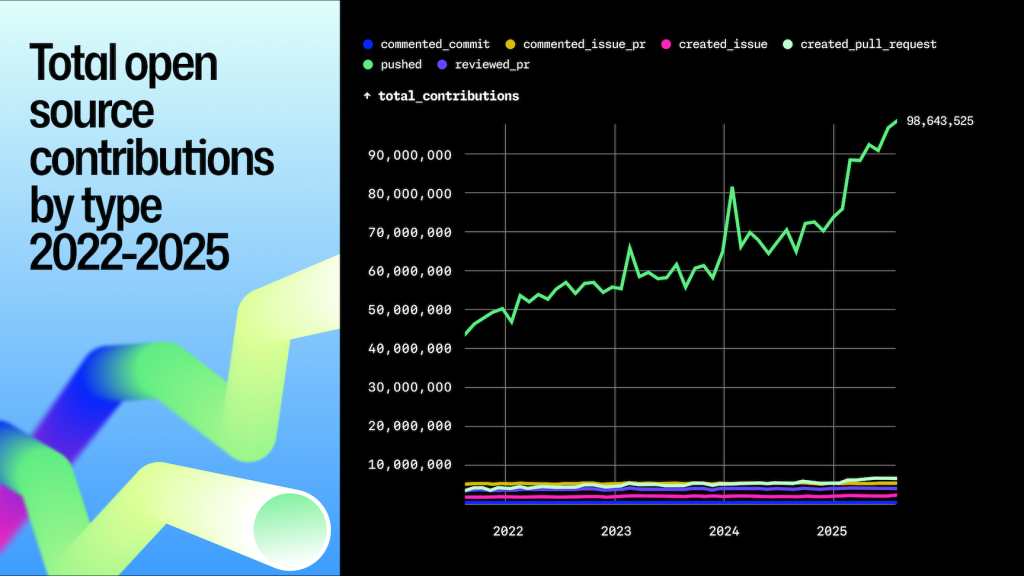
Notebooks are now a mature tool for experimentation, while Dockerfiles are considered the bridge to reproducibility and production. In 2025, 2.4 million repositories used Notebooks (+75% YoY) and 1.9 million used Dockerfiles (+120% YoY). This growth is likely fueled by the need to sandbox agents and LLMs, and containerization is a practical method to run and scale them securely.
| Repositories in 2024 | Repositories in 2025 | Delta | |
|---|---|---|---|
| Jupyter Notebook present | 1.4M | 2.42M | +75% |
| Dockerfile present | 875k | 1.9M | +120% |

The last five years have redrawn not just GitHub’s developer map, but also the distribution of global activity, faster than any period on record.
India added more than 5.2 million developers in 2025, which accounts for a little over 14% of GitHub’s total +36 million new developers in 2025. That makes India the single largest source of new developers on GitHub this year, continuing its rapid rise since 2020.
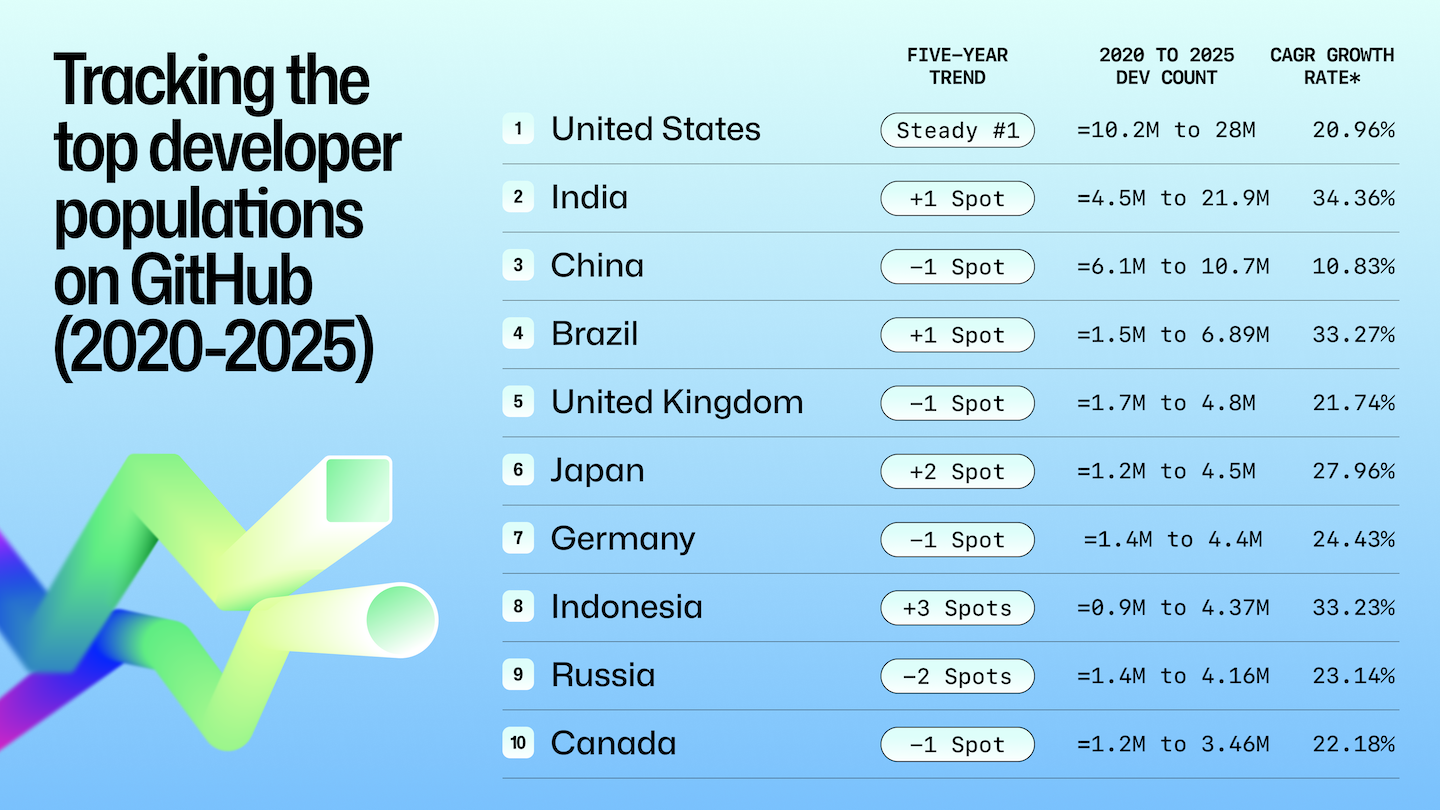
| Region | Stand‑out markets | 2024 to 2025 net new devs | What’s fueling the boom |
|---|---|---|---|
| APAC | India, Japan, Indonesia, | +13M | Government skilling, AI‑assisted local‑language tooling. Japan, in particular, has embraced digital transformation in recent years, leading to a boom in developers. |
| LATAM | Brazil, Mexico, Colombia | +3.2M | Remote hiring by US/EU firms, fintech startup density |
| Europe | Germany, United Kingdom, France | +6.3M | Cloud infrastructure spend, AI investment, startup‑visa pipelines |
| Africa & the Middle East | Nigeria, Turkey, Egypt | +3.4M | Increased mobile adoption, community bootcamps, LLMs that work locally |
Looking ahead, our data team modeled the next five years of developer growth using regression analysis, which can help to capture more of the real-world dynamics impacting the data. (You can get more information about this in our methodology section.)
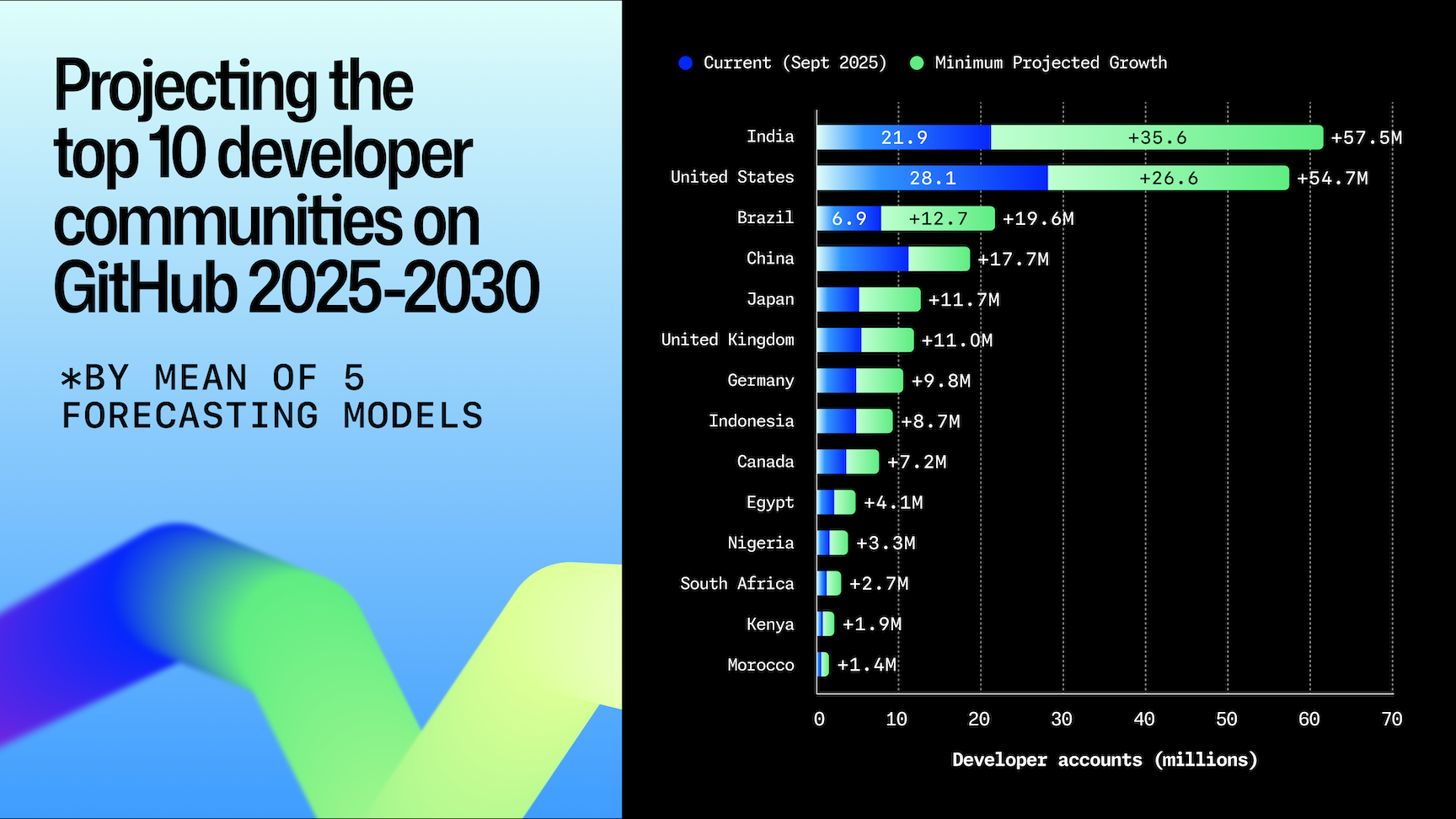
The results of our analysis suggest India will continue to expand its lead, reaching 57.5 million developers by 2030, and accounting for more than one in three of all projected sign ups worldwide. The United States will be the second-largest community with more than 40 million developers expected, while Brazil (19.6M), Japan (11.7M), and the United Kingdom (11M) round out the top five.
Notably, emerging regions across Africa and the Middle East show momentum with Egypt, Nigeria, Kenya, and Morocco all projected to add millions of developers in the coming years. This points to a developer population that is not only growing but diversifying geographically at unprecedented speed.

Open source development reached record levels this year with 1.12 billion contributions across public repositories (+13% YoY). March 2025 marked the largest single month of new open source contributors in GitHub history: 255,000 first-timers.
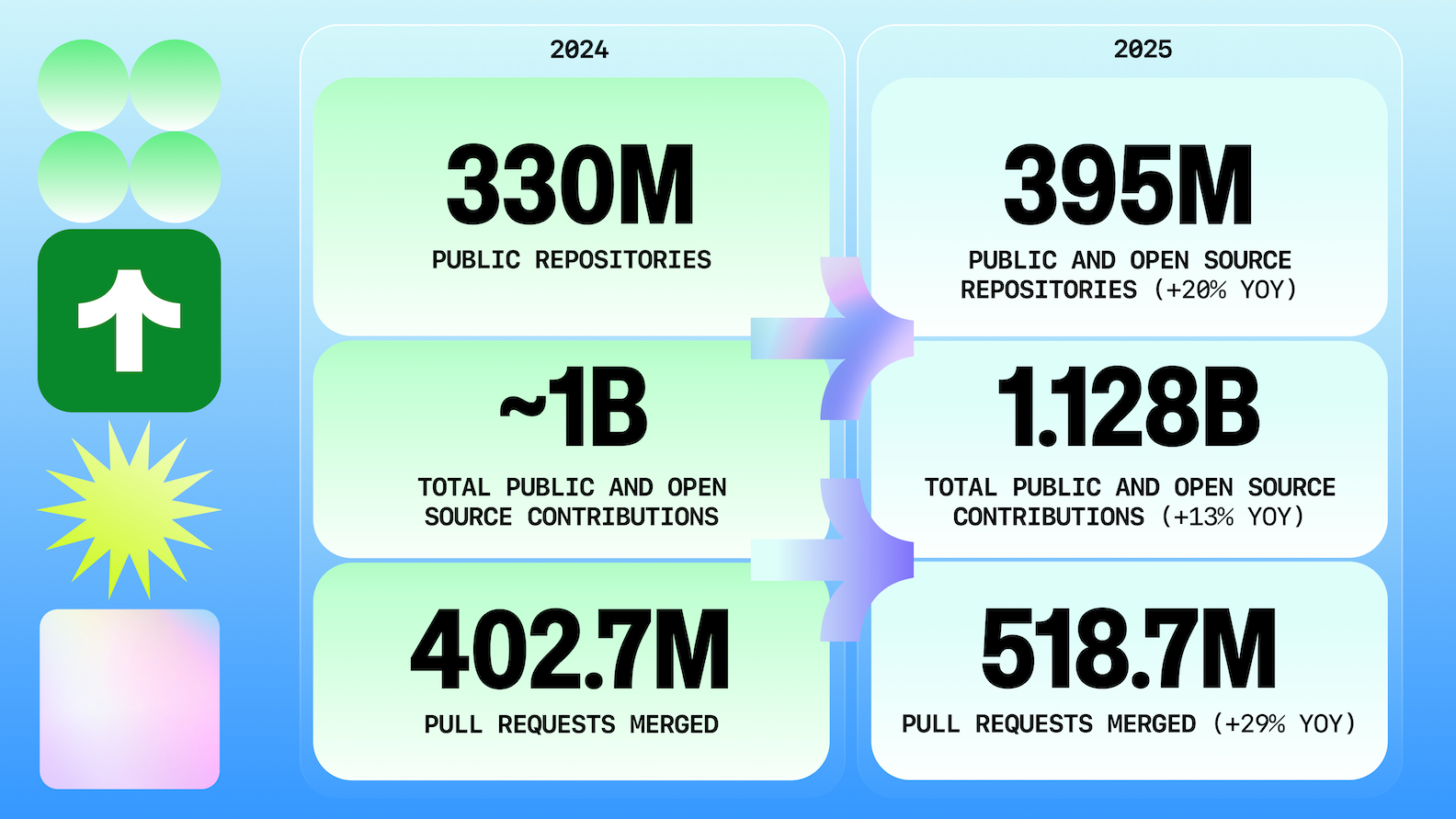
In total, 395 million public repositories hosted 1.12 billion contributions and 518.7 million merged pull requests—each a record.
Six of the 10 fastest-growing repositories were AI infrastructure projects, underscoring demand for runtimes, orchestration, and efficiency tools.
Standards also saw big growth: Model Context Protocol (MCP) hit 37k stars in just eight months, though it’s not on our lists below.
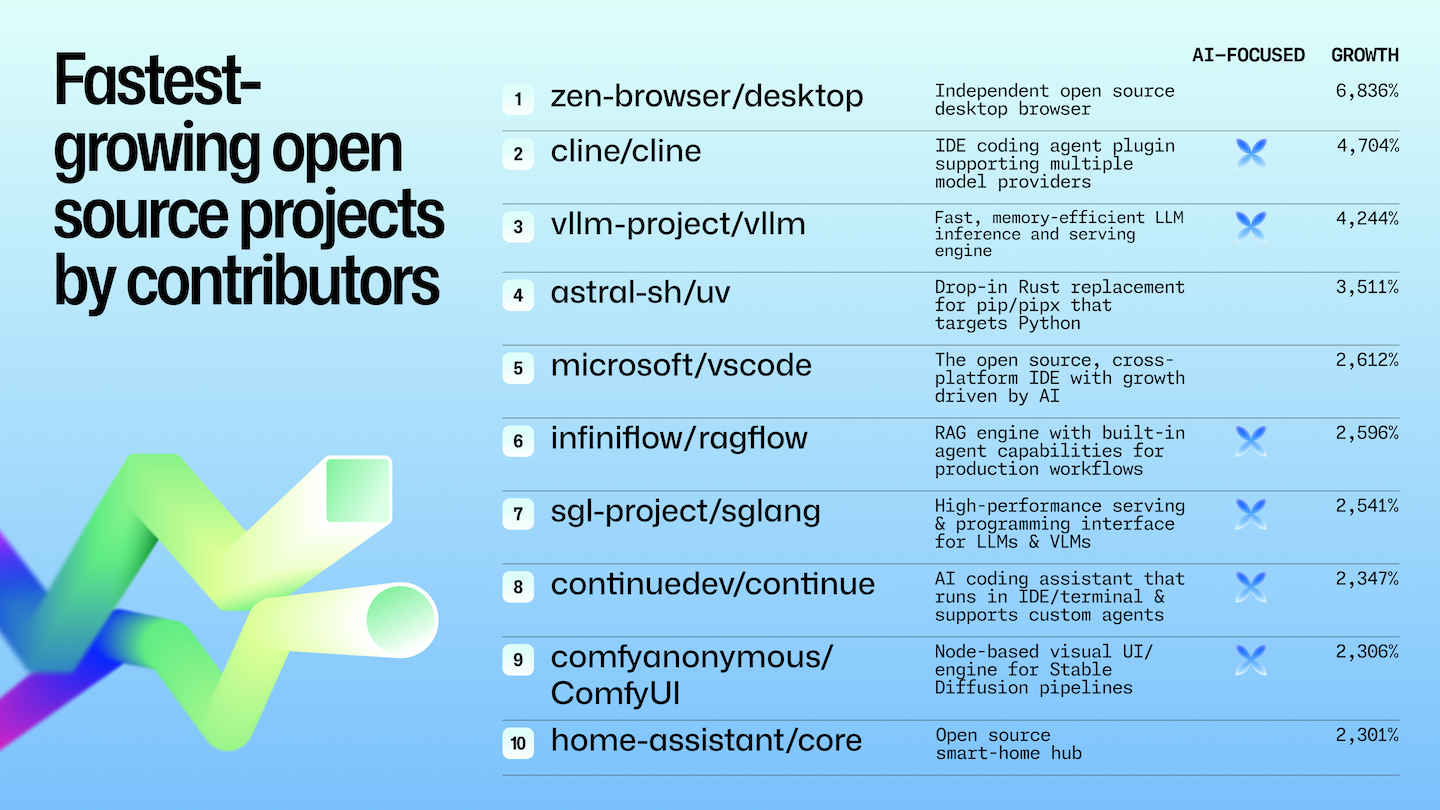
2025’s top projects split between AI infrastructure (vllm, ollama, huggingface/transformers) and enduring ecosystems (vscode, godot, home-assistant).
The takeaway? AI infrastructure is emerging as a major magnet, but developer ecosystems remain strong.
| Rank | Repository | Short description |
|---|---|---|
| 1 | vllm-project/vllm | High-throughput LLM inference engine |
| 2 | microsoft/vscode | Widely used open source code editor |
| 3 | openai/codex | Lightweight coding agent that runs in the terminal |
| 4 | huggingface/transformers | Core library for model loading & fine-tuning |
| 5 | godotengine/godot | Game engine for 2D/3D development |
| 6 | home-assistant/core | Open source smart-home hub |
| 7 | ollama/ollama | Local model runner and management tool |
| 8 | ggml-org/llama.cpp | Lightweight local Llama inference |
| 9 | volcengine/verl | LLM deployment & serving framework |
| 10 | expo/expo | React Native toolkit for mobile apps |
We see a mix of projects driving the fastest growth. zen-browser/desktop leads the pack, with fast-rising, AI-focused projects like vllm-project/vllm, continue-dev/continue, ollama/ollama, and Aider-AI/aider showing the pull of local inference, coding agents, and model runners.
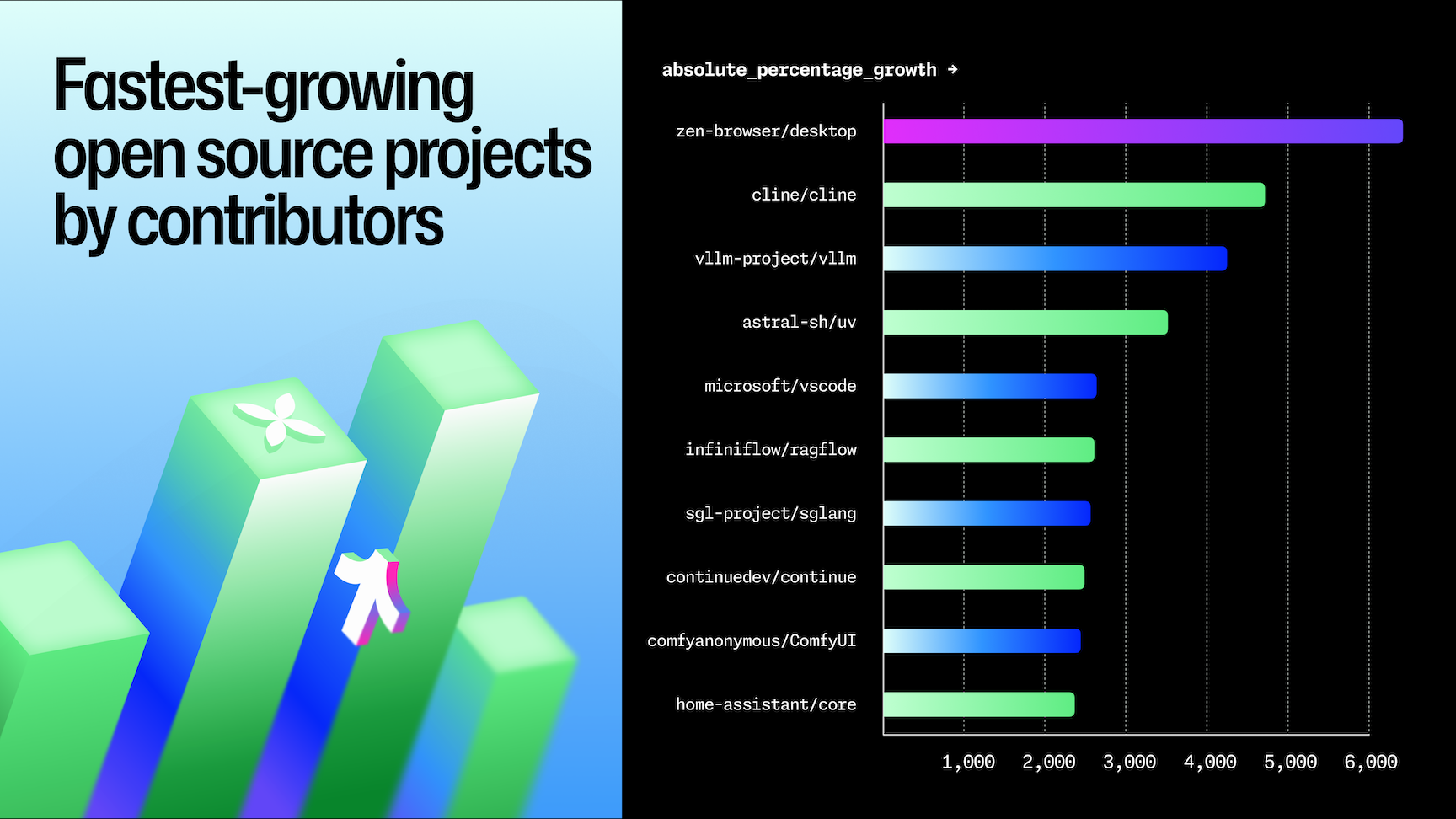
Growth in open source is broad. AI infrastructure projects are prominent among top-growth repositories. When we zoom out to the top 20 projects (not all of these are captured in our above graphic), we see a few things at play:
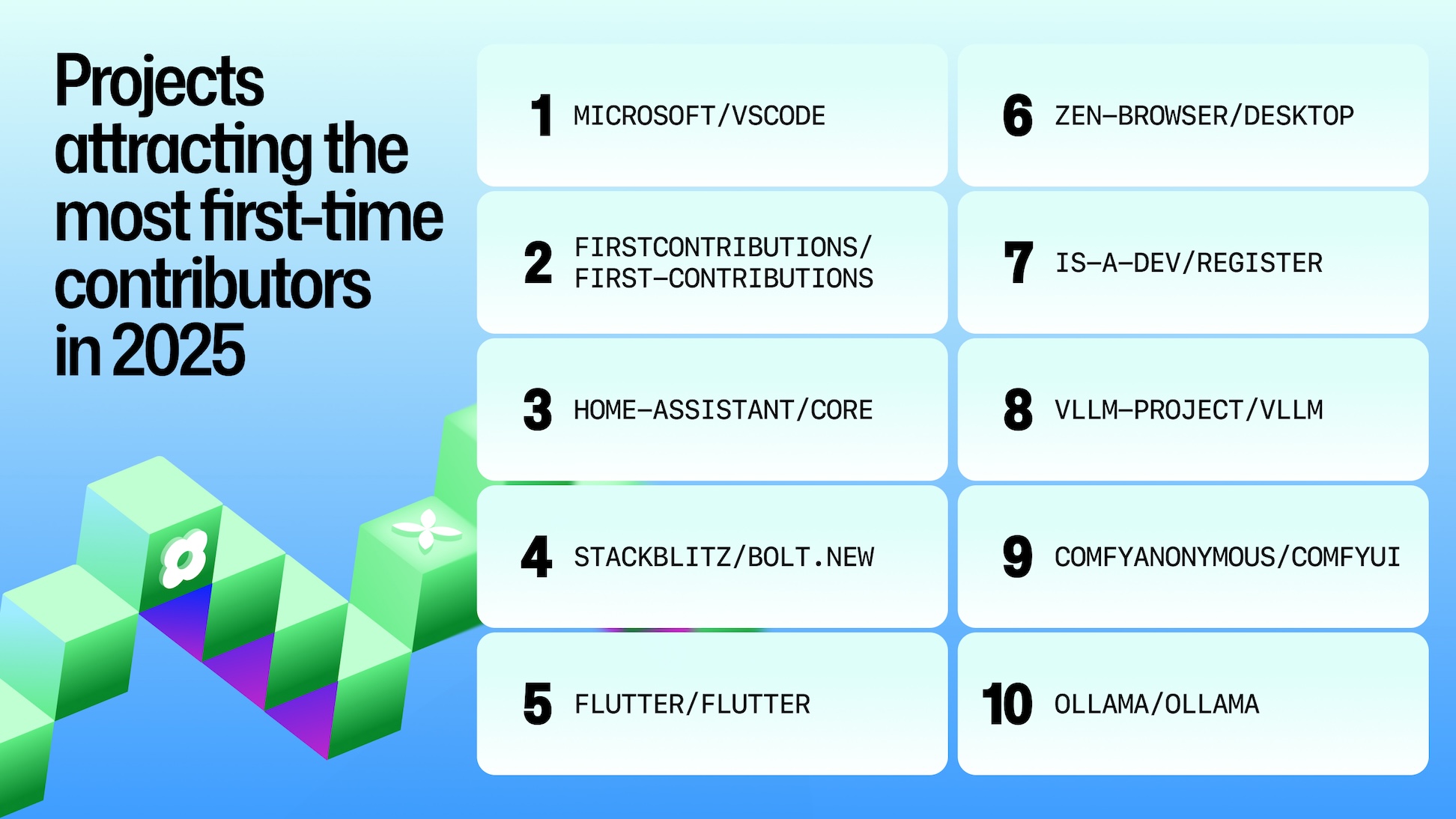
Nearly 20% of the most popular open source projects among first-time contributors in 2025 were AI-focused. But we’re also seeing other project types capture mindshare among developers who are new to open source.
Frontend and dev tool projects also light up. shadcn/ui and uBlockOrigin/uAssets show that CSS, UI, and browser tooling remain magnets for fresh contributors.
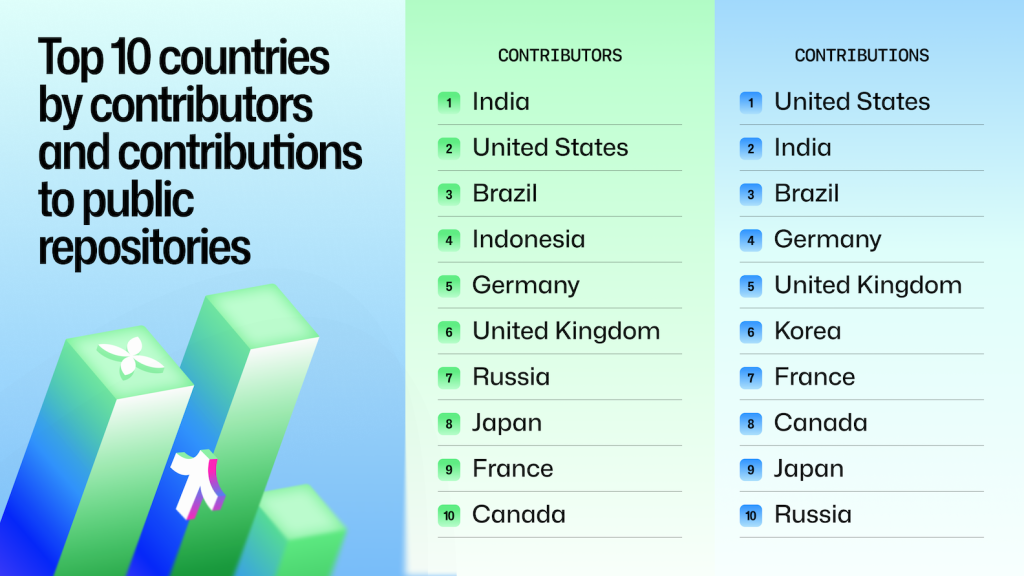
Governance is not keeping pace with velocity. This gap presents an opportunity for developers, organizations, and companies to contribute documentation as well as code.
Key repository files like README or a LICENSE file are more than formalities. They’re foundational to scaling inclusive, legal, secure, and sustainable collaboration. This guide to getting your repository collaboration-ready shares what documentation is most important for fostering a sense of shared ownership.

Average fix times for critical severity vulnerabilities have improved by 30% over the past year, as remediation is beginning to keep pace with faster software development.
Automation is driving this acceleration. Dependabot usage more than doubled (846k projects, +137% YoY), and AI tools like Copilot Autofix are resolving common OWASP Top 10 issues across thousands of repositories every month. This is underscored by the fact that in 2025, 26% fewer repositories received critical alerts through a combination of increased automation and AI usage.
At the same time, new risks are emerging. Broken Access Control overtook Injection as the most common CodeQL alert, flagged in 151k+ repositories (+172% YoY). Much of this stems from misconfigured permissions in CI/CD pipelines and AI-generated scaffolds that skip critical auth checks (GitHub’s engineers published a walkthrough of how they improved their SAML authentication flow, which offers some valuable lessons).
Developers are automating more build, test, and security activity. In 2025, we saw developers use 11.5 billion total GitHub Actions minutes (measured in CPU minutes) in public projects for free. That’s up 35% year over year from 8.5 billion GitHub Actions in 2024. Note: in last year’s report, we included GitHub Actions minutes across public projects and self-hosted usage. If we use the same rubric this year, 13.5 billion minutes were used, which is up 30% from last year.
Automation raises fixes quickly, but merges still stall when approval depends on humans or policy. Projects that configure Dependabot with auto-merge rules remediate vulnerabilities more consistently than those relying solely on manual review.
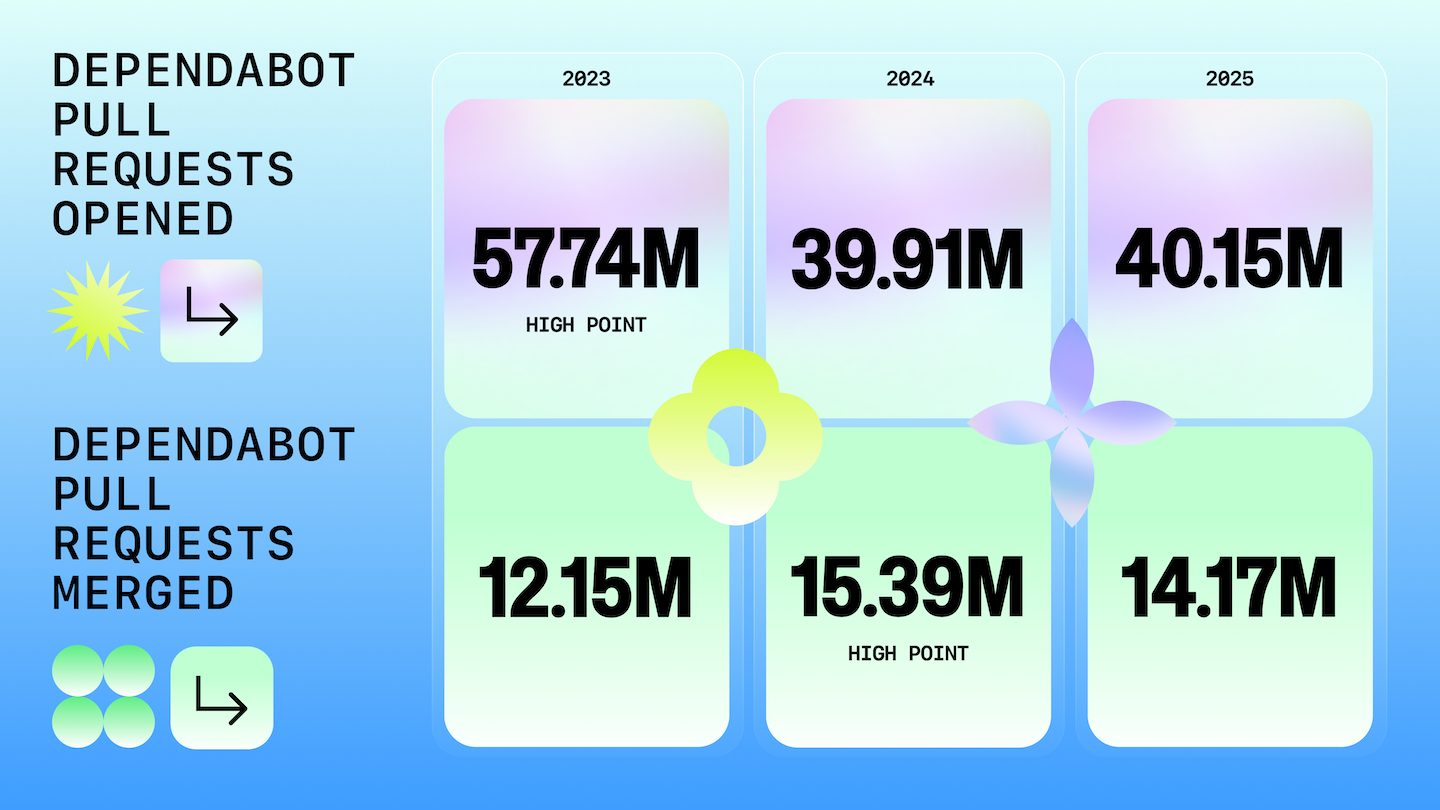
In 2025, we saw 30% faster fixes of critical severity vulnerabilities with 26% fewer repositories receiving critical alerts. And this acceleration is happening at scale with the average fix time shrinking from 37 to 26 days in total.
Repositories that define Dependabot behavior in dependabot.yml more than doubled this year (846k, +137% YoY), marking a shift from “notify me” to “patch me automatically, within guardrails.”
| Signal | 2024 (cumulative) | 2025 (cumulative) | YoY |
|---|---|---|---|
Repositories with dependabot.yml | 356k | 846k | +137% |
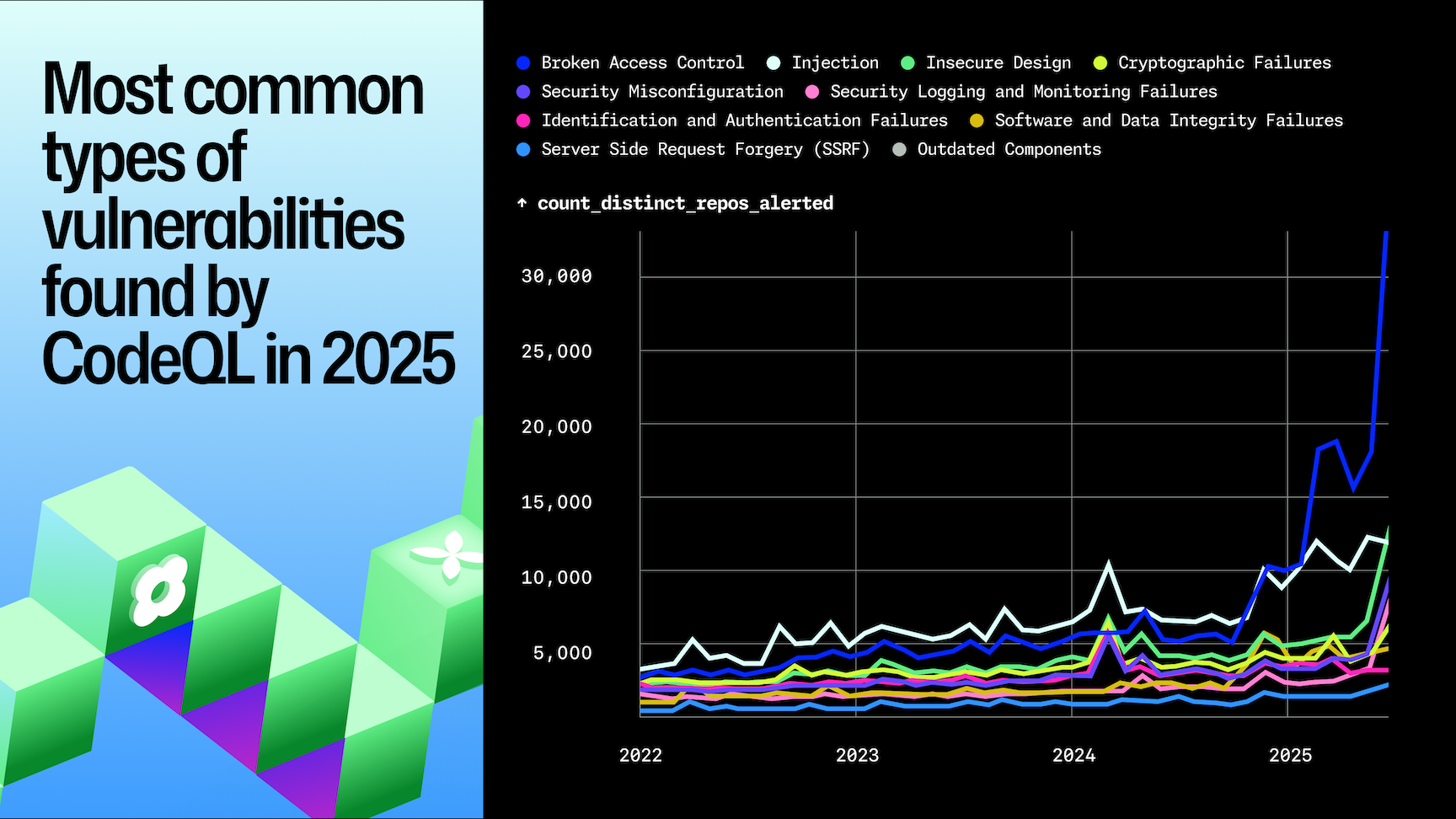
Broken Access Control overcame Injection to become the top CodeQL alert, flagged in 151k+ repositories. New CodeQL coverage for GitHub Actions revealed widespread misconfigured permissions and token scopes.
This points to a broader issue: authentication and authorization remain difficult for both developers and LLMs. Injection still dominates JavaScript, but Broken Access Control now leads in Python, Go, Java, and C++ (languages where AI-assisted “vibe coding” sometimes scaffolds endpoints that look correct but lack critical auth checks).
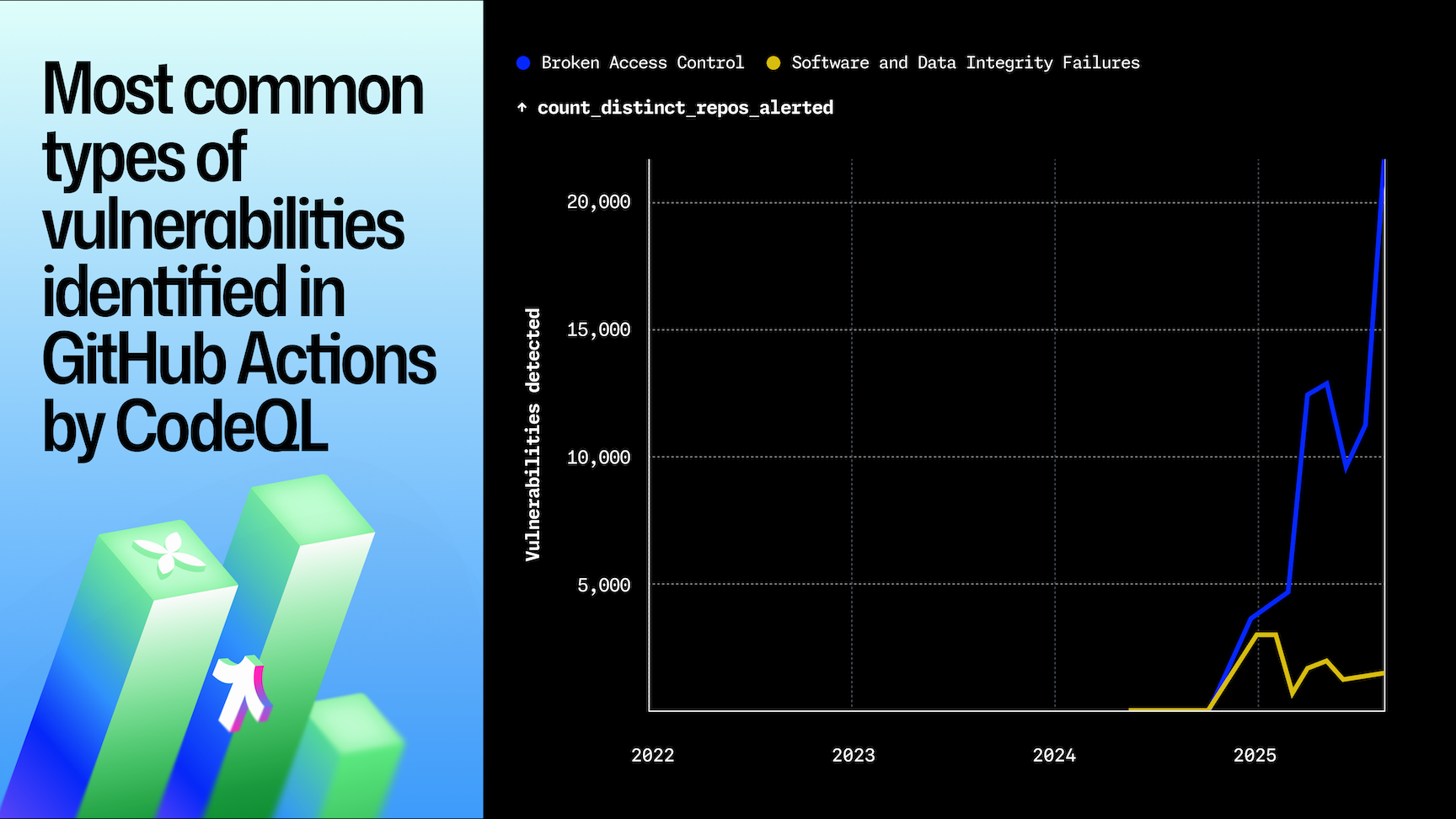
That same category became the fastest-growing target for Copilot Autofix. By mid-2025, developers were accepting AI-generated fixes for Broken Access Control in 6,000+ repositories per month. Autofix also gained traction for Injection (3,100 projects), Insecure Design (2,300 projects), and Logging/Monitoring failures (3,500 projects).
OpenSSF Scorecard status: 47 of the top 50 open source projects (94%) defined by their Mona ranking (combined ranking of stars, forks, and issue authors) now use the OpenSSF Scorecard via GitHub Actions or are independently scanned, bringing real-time checks for security best practices.

By GitHub contributor counts, August 2025 marks the first time TypeScript emerged as the most used language on GitHub, surpassing Python by ~42k contributors (other industry indices use different methodologies and may still rank JavaScript and Python higher). This caps a decade-long trend of developers shifting toward typed JavaScript and signals a new default for modern development.
Together, TypeScript and Python now account for more than 5.2 million contributors (roughly 3% of all active GitHub developers in August 2025). The rise of typed languages suggests AI isn’t just changing the speed of coding, but also influencing which languages teams trust to take AI-generated code into production.
| Rank 2025 | Language | YoY contributor gain | YoY % growth (Aug 2024 vs. Aug 2025) | Big takeaway |
|---|---|---|---|---|
| 1 | TypeScript | ~1,054,015 | 66.63% | TypeScript overtook Python and JavaScript for #1 growth, showing its dominance in new green-field development. |
| 2 | Python | ~850,579 | 48.78% | Considered the lingua franca of AI and ML, Python’s usage has increased significantly amidst generative AI work. |
| 3 | JavaScript | ~427,148 | 24.79% | Still massive in scale, but more incremental growth as usage shifts toward TypeScript. |
| 4 | Java | ~174,705 | 20.73% | Java continues its steady enterprise-driven growth. |
| 5 | C# | ~136,735 | 22.22% | Cloud, desktop, and game dev keep momentum for C#. |
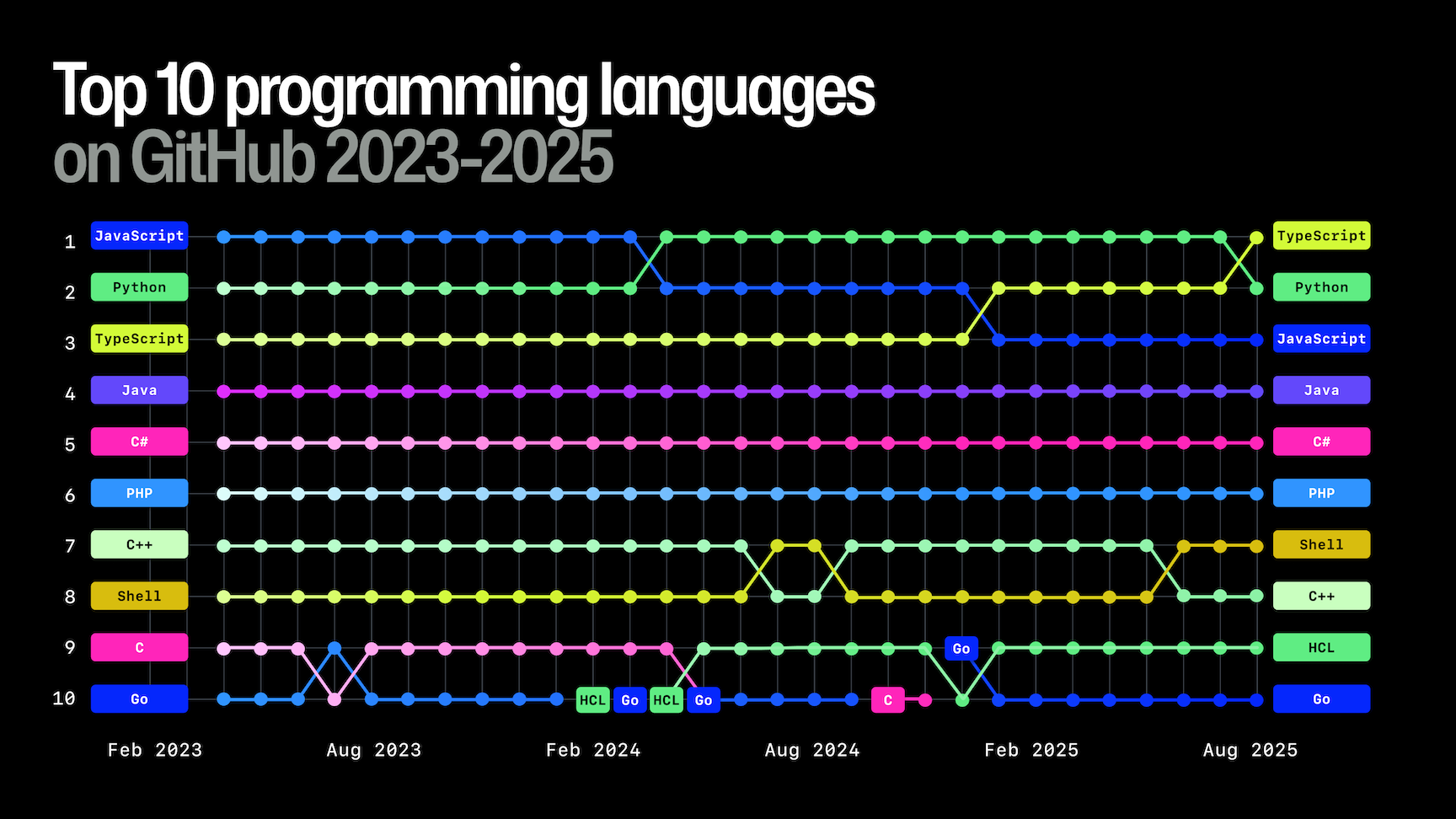
Python still trails the combined JavaScript and TypeScript ecosystem, a continuation of last year’s trend that highlights just how large the typed and untyped JavaScript community remains.
But starting in 2025, Python’s growth curve began to track almost identically in parallel with JavaScript and TypeScript, suggesting that AI adoption is influencing language choice across these ecosystems.
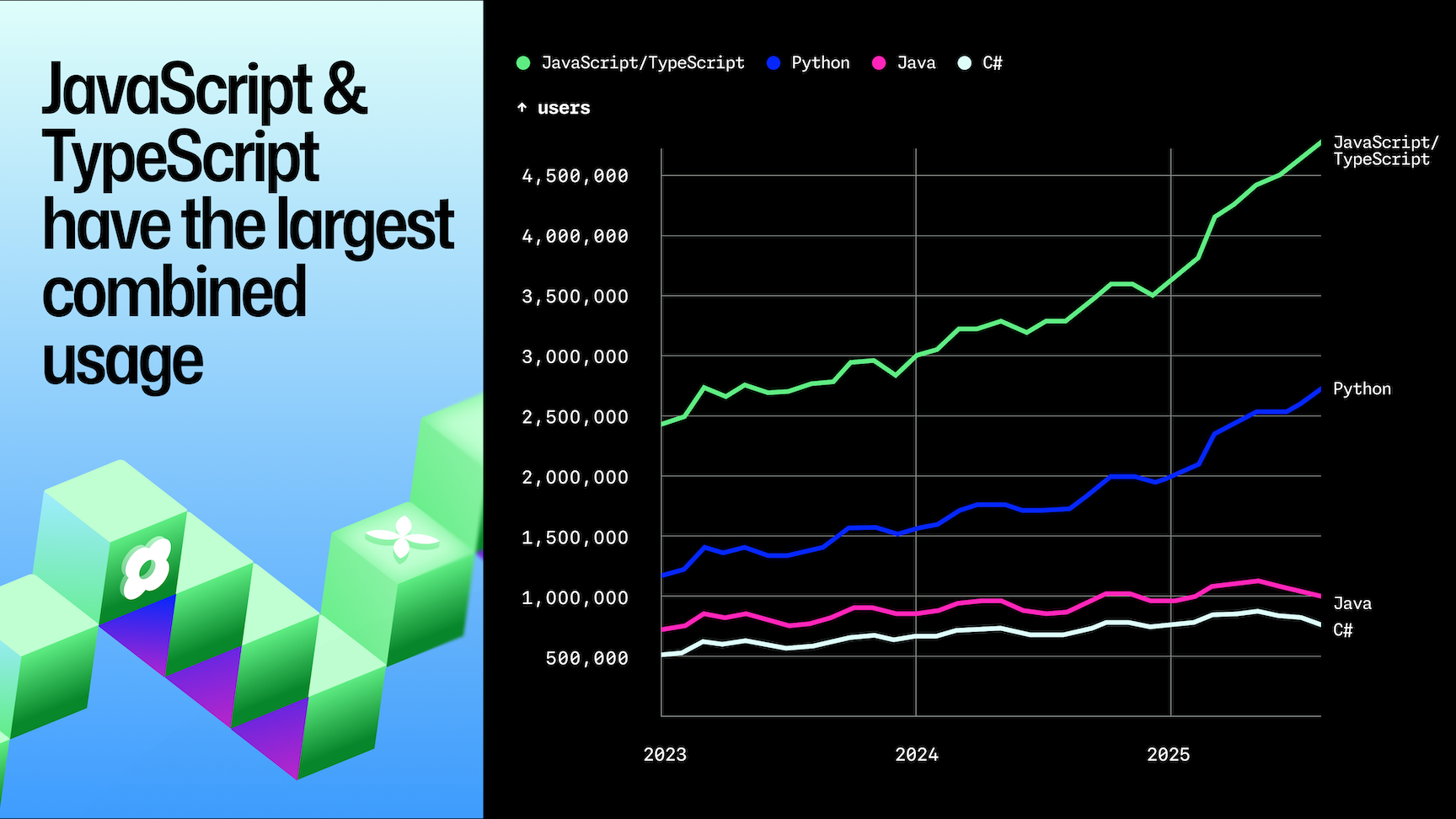
The following languages may not have the biggest developer communities behind them, but each has at least 1,000 monthly contributors and they’re posting the fastest year-over-year growth rates on GitHub.
| Language | Current developer count | YoY % | Why it’s hot |
|---|---|---|---|
| Luau | >3,600 | >194% | Luau is Roblox’s scripting language and a gradually typed language, reflecting a broader industry trend toward typed flexibility. |
| Typst | >3,600 | >108% | As a modern LaTeX alternative, Typst aims to make academic and technical publishing faster, less cryptic, and more collaborative. |
| Astro | >45,600 | >78% | Astro’s “islands architecture” and focus on shipping zero-JavaScript by default resonate with developers building fast, content-heavy sites (we added Astro to Linguist in 2021, which is our source for languages). |
| Blade | >91,100 | >67% | As Laravel’s templating engine, Blade rides on Laravel’s continued dominance in PHP web development. |
| TypeScript | >2,600,000 | >67% | Offering type safety for the JavaScript world, TypeScript’s combination of JavaScript ubiquity and type safety is compelling for both greenfield and legacy projects (plus, its types work well with AI coding tools). |
Nearly 80% of new repositories used just six languages: Python, JavaScript, TypeScript, Java, C++, and C#. These core languages anchor most modern development.
| Language | Total repositories (Sep 2024-Aug 2025) | Growth (Jan-Aug 2025 vs. Jan-Aug 2024) | What this growth tells us |
|---|---|---|---|
| Python | 9,261,587 | 53.41% | AI’s default glue with growth driven by ML, agents, notebooks, and orchestration. |
| JavaScript | 9,345,046 | 14.57% | Still ubiquitous for scripts and web apps, though growth is slower as TypeScript gains share. |
| TypeScript | 5,394,256 | 78.10% | Typed standard for modern web dev. Ideal for safe API/SDK integration, especially with AI. |
| Java | 3,520,215 | 9.35% | Reliable enterprise and backend workhorse. Gradual AI integration without language churn. |
| C++ | 1,701,552 | 11.82% | Performance-critical workloads used in game engines, inference, and embedded systems supporting AI. |
| C# | 1,478,463 | 10.61% | Steady enterprise and game dev usage, with AI capabilities folded into established ecosystems. |
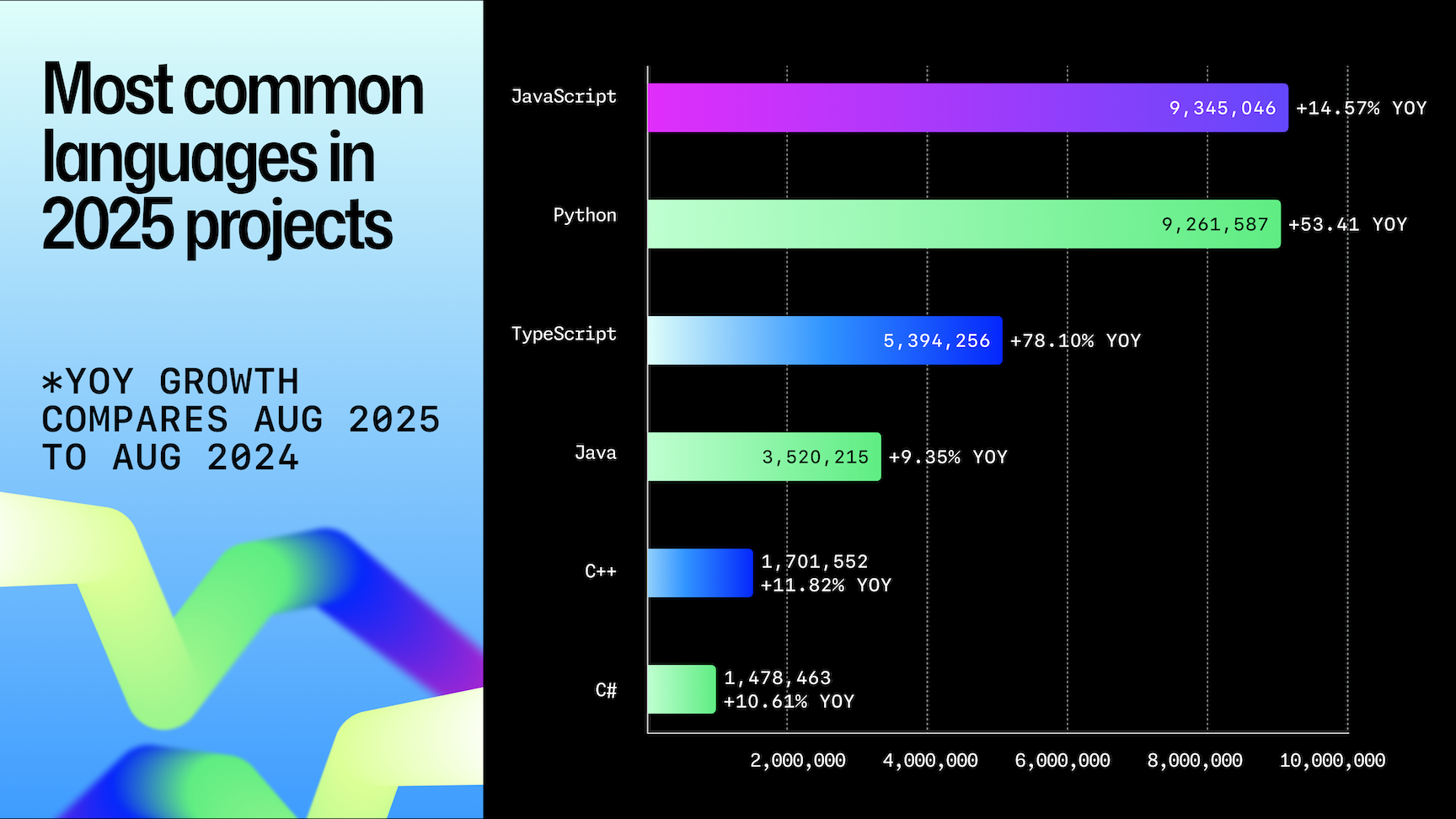
Additional insights:
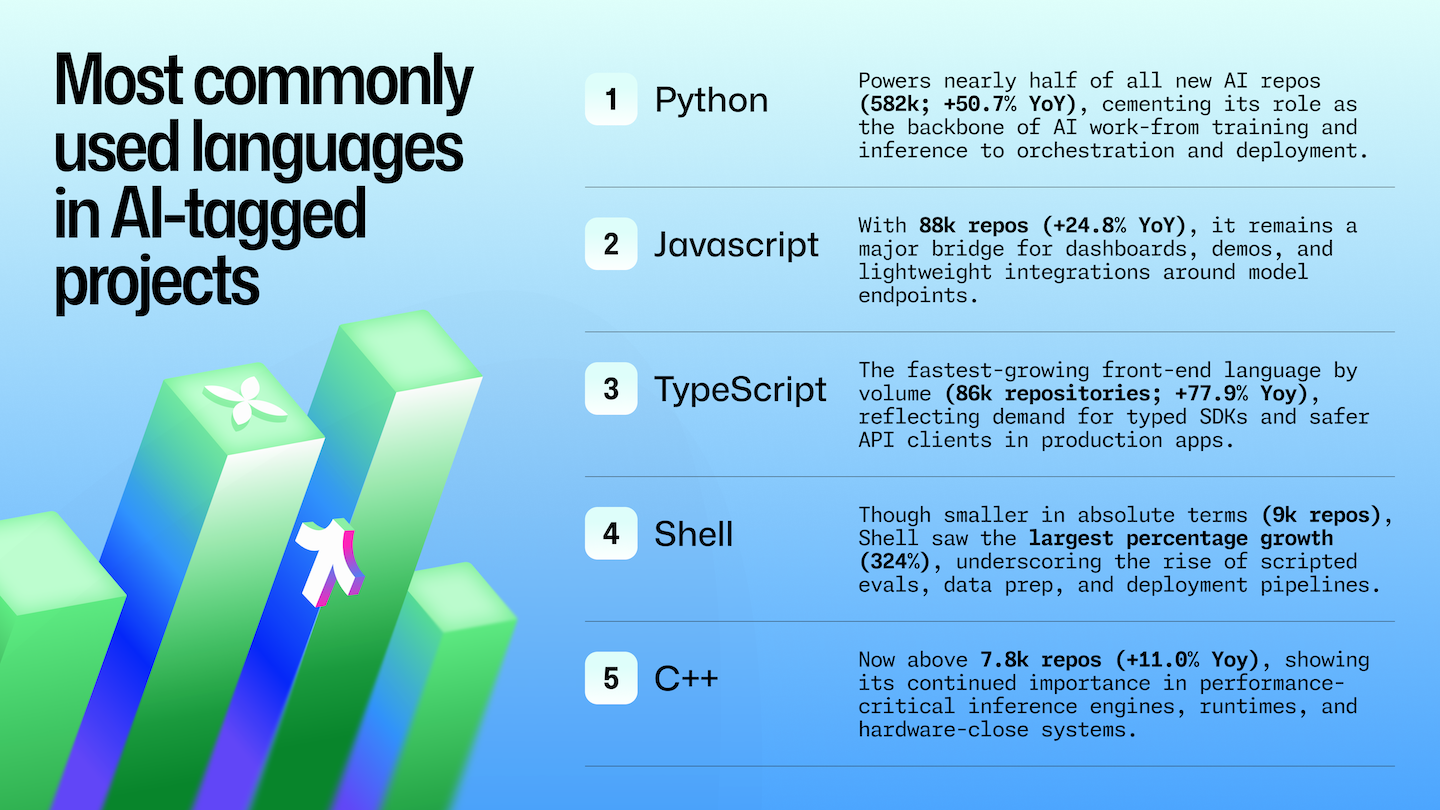
Python and Jupyter Notebook continue to anchor new AI projects, but the story this year is Python’s growth. Python now powers nearly half of all new AI repositories (582,196; +50.7% YoY), underscoring its role as the backbone of applied AI work, from training and inference to orchestration and deployment. Jupyter Notebook remains the go-to exploratory environment for experimentation (402,643; +17.8% YoY), but the shift toward Python codebases signals more projects moving out of prototypes and into production stacks.
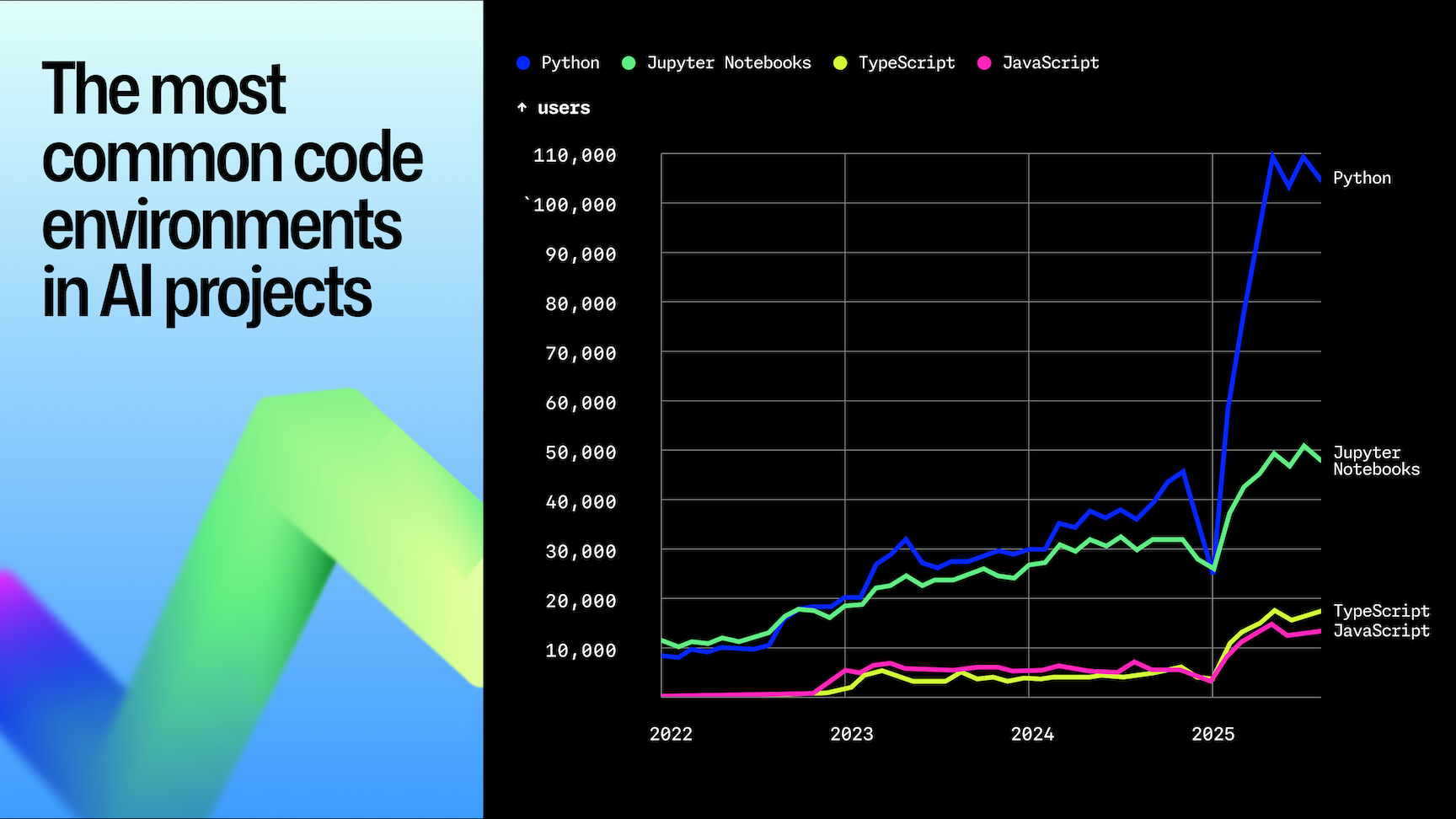
Front-end and app-layer languages grew sharply from smaller bases—TypeScript +77.9% (85,746) and JavaScript +24.8% (88,023)—mirroring the rise of demos, dashboards, and lightweight apps built around model endpoints. Shell scripts (+324%) emerged as the fastest riser, reflecting how teams codify eval harnesses, data prep, and deployment pipelines. And C++ crossed 7,800 repos (+11%), a steady reminder of its role in performance-critical inference engines, runtimes, and hardware-close systems.

Last year we saw AI move from experiment to mainstream. In 2025, it became part of the everyday workflow. And no matter what tool developers used over the last 12 months, their work converged on GitHub.
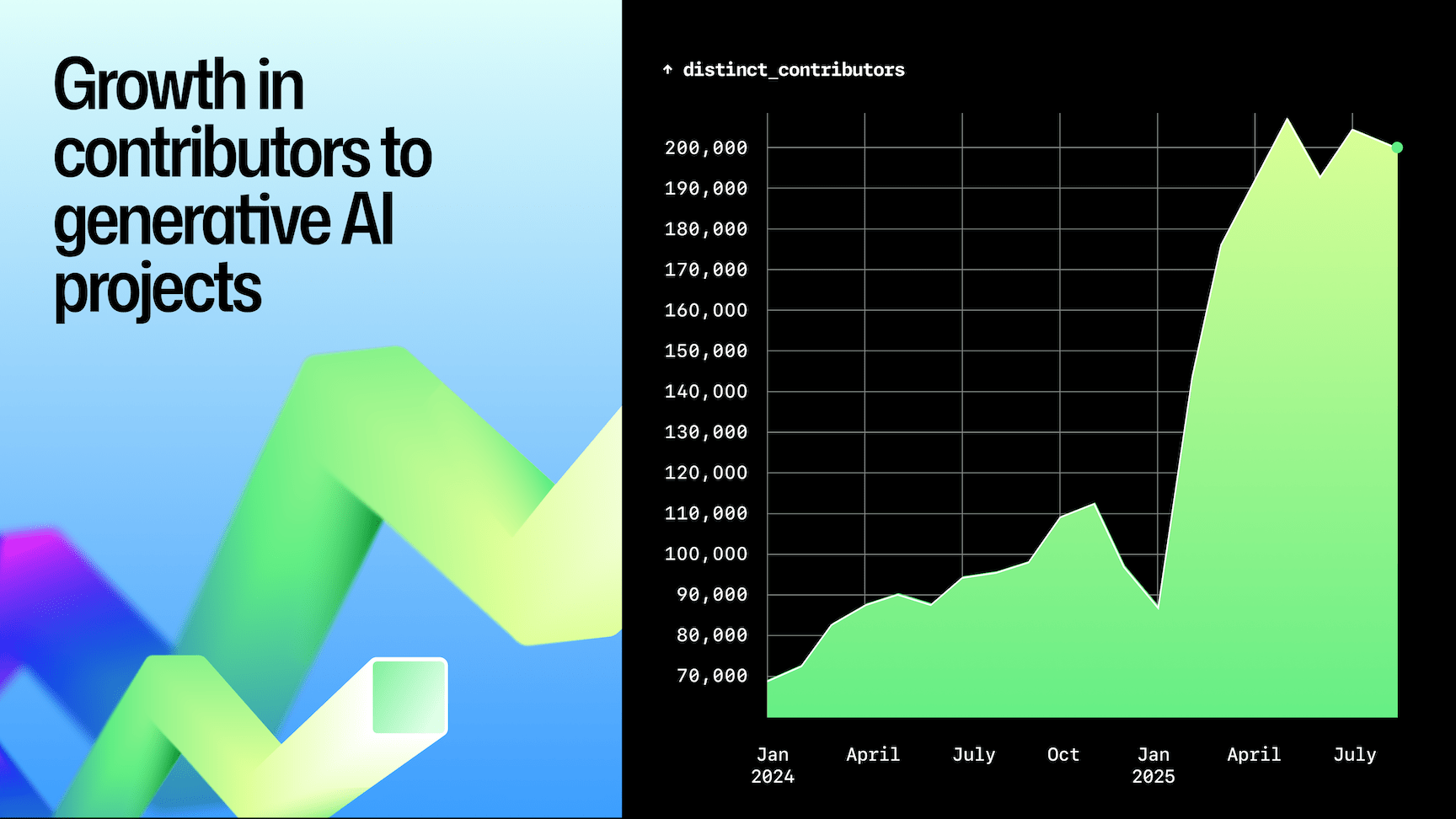
Monthly contributors to generative-AI projects climbed sharply across our measurement year. From September 2024 through August 2025, months averaged ~151k contributors (median ~160k). Activity rose from ~86k in January 2025 to a peak of 206,830 in May (+132% YoY vs. May 2024). It then held near ~200k through the summer. On a like-for-like basis, Jan–Aug 2025 averaged ~175k contributors, up +108% YoY vs. Jan–Aug 2024 (~84k), indicating a durable step-change rather than a one-off spike.
Key takeaways:
| Data point | Why it matters | |
|---|---|---|
| 178% YoY increase in projects that import an LLM SDK | 1.13M+ public repositories now import an LLM SDK; 693k+ were created in the last 12 months alone. | Growth rates indicate a shift from early experimentation to sustained building. |
| Contributors up >3X since 2023 | Monthly distinct contributors to AI repos rose from 68k (Jan 2024) to ~200k (Aug 2025). August 2025 is up 111% YoY vs. August 2024. | AI work is no longer the domain of specialists. |
| Monthly contributions near 6M | Monthly commits/contributions to AI projects reached ~6.0M (Aug 2025) hitting a peak of 6.28M (Jun 2025). August 2025 is up 188% YoY vs. August 2024. | More code, more often, offering evidence of production-grade adoption and active iteration. |
1.13M+ public repositories now depend on generative-AI SDKs (up 178% YoY). More than 693k+ were created in the last 12 months, sharply outpacing 2024’s total (~400,000). The compounding curve that began in early 2023 shows no sign of tapering; every week, on average, we are still seeing new all-time highs.
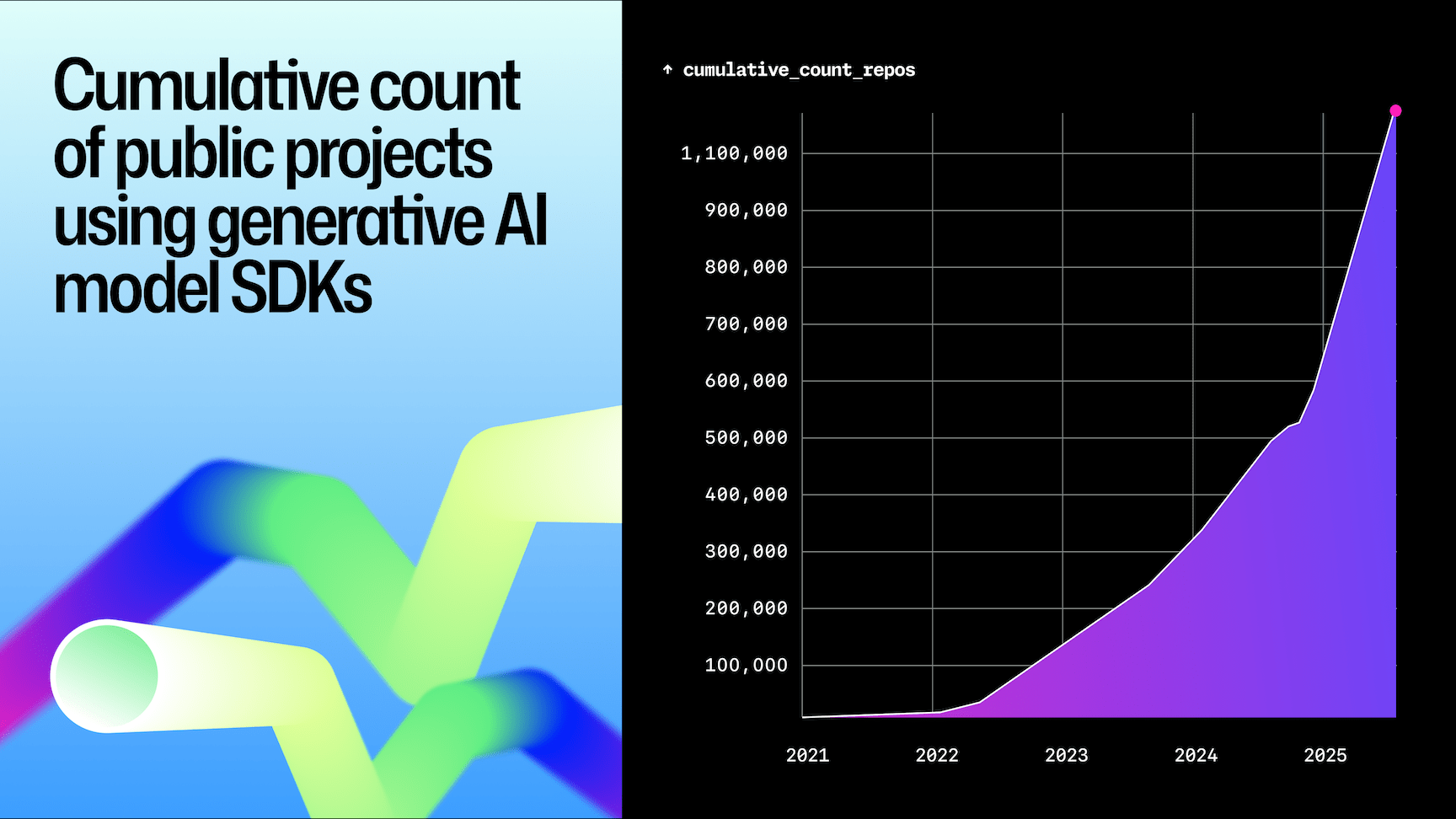
The U.S. remains the largest source of contributions (~12.8M, 31.8%). India ranks second (~5M, 12.5%) and leads by distinct repositories (405k vs. 342k).
A second tier (Germany, Japan, U.K., Korea, Canada, Brazil, Spain, France) contributes another ~40%, globalizing the map.
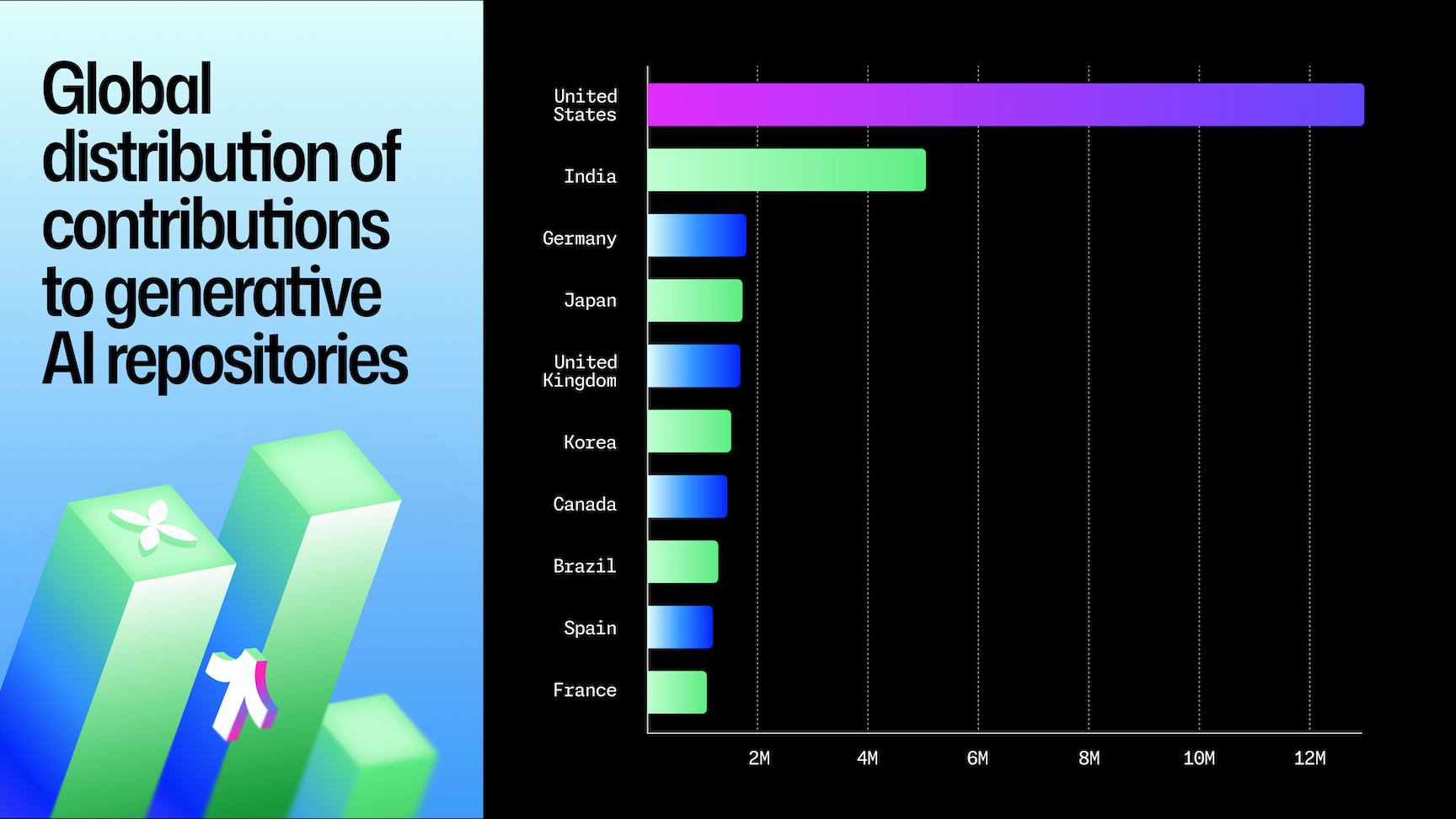
This year, GitHub Copilot coding agent went from demo to GA and we’re starting to see its impact.
A first glimpse of coding agent shows 1+ million pull requests that were created between May 2025 and September 2025.
Where it’s showing up:
A repository-level comparison of public repositories with ≥1 coding agent-authored pull request vs. a random sample without Copilot coding agent shows strong selection effects: coding agent activity is skewed toward repositories with more stars, larger size, and greater age. In other words, teams aren’t only assigning coding agent to throwaway projects; they’re trying it in better-known, more established projects as well.
We invite the community to run within-repository experiments (A/B or stepped-wedge) and matched analyses conditioned on size, stars, age, and complexity proxies to establish robust baselines. We’ll continue looking into this as we evolve coding agent across GitHub, the Copilot CLI, and more.
Generative AI projects continue to be among GitHub’s most popular. Projects like vllm, ragflow, and ollama outpaced the historical contributor growth of staples such as vscode, home-assistant, flutter.
| Repository (age ≤3 yrs unless noted) | AI connection |
|---|---|
| vllm-project/vllm | Open source vision-language model + training/inference stack |
| ggml-org/llama.cpp | Local Llama inference on CPU/GPU |
| infiniflow/ragflow | End-to-end retrieval-augmented-generation (RAG) template |
| cline/cline | “LLM-native” command-line shell that reasons over local context |
| huggingface/transformers (6.6 yrs) | Defacto Python library for model loading/fine tuning |
GitHub Copilot Autofix contributed to measurable improvements in 2025:
Early adopters using agents, open standards, and self-hosted inference are already setting the norms for the next decade. Continuous AI—systems and workflows that are updated, retrained, and deployed on an ongoing basis—is emerging.
Three years ago, we said AI wouldn’t replace developers—it would bring more people into the ecosystem. The data now proves it: activity on GitHub has reached record levels, with more contributors, more repositories, and more experimentation than ever.
The past year marked historic milestones:
The story of 2025 isn’t AI versus developers. It’s about the evolution of developers in the AI era where they orchestrate agents, shape languages, and drive ecosystems. No matter which agent, IDE, or framework they choose, GitHub is where it all converges.
Scope & coverage
Time windows
Units & entities
Growth baselines
Geography
Repository & language classification
Statistical techniques
User de-duplication
Data quality controls
Interpretation & reproducibility
Developer growth projections

At Universe 2025, GitHub’s next evolution introduces a single, unified workflow for developers to be able to orchestrate any agent, any time, anywhere.

GitHub celebrates its 2025 Partner Award winners, honoring global, regional, and technology partners for driving innovation, collaboration, and impact across the developer ecosystem.

If alone time is your love language—don’t worry, it’s ours too—you can still attend, learn from, and enjoy big events like GitHub Universe. Here are some practical tips on how.